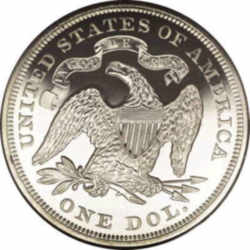

Florida Symbols
- » 50 States »
- » Histories »
- » State Symbols »
- » Mottos
Florida State Motto
"In God We Trust"

Adopted in 1868; July 1, 2006
Language: English
Focus: Religious
In God We Trust has come to be accepted as the motto of Florida as an element of the Great Seal of the State of Florida. Like many states, Florida has not specifically adopted an official state motto until on June 22, 2006, Governor Jeb Bush signed House Bill no. 1145 adopting In God We Trust as the official state motto of Florida, effective July 1, 2006.
The motto of the State of Florida may sound familiar. It's the same motto as the national motto of the United States picked by Secretary of the Treasury Salmon P. Chase in 1863 to appear on some coinage of the "Union" side during the Civil War. Evidently this was to indicate exactly which side had the upper hand in the conflict. In God We Trust came to replace E Pluribus Unum and was officially adopted as the national motto in 1956. The motto's intent is clear. It expresses a definite faith in a deity referred to as God.
Florida State Motto: "In God We Trust
There are four states with mottos that mention "God." Most people would probably regard them as being religious mottos:
- Arizona: "Ditat Deus" This means "God Enriches in Latin."
- Florida: "In God We Trust." - identical to the current national motto
- Ohio: "With God, All Things Are Possible." This is a direct biblical quotation from the King James Version of Matthew 19:25-26: "When his disciples heard it, they were exceedingly amazed, saying, Who then can be saved? But Jesus beheld them, and said unto them, With men this is impossible; but with God all things are possible."
- South Dakota: "Under God, The People Rule."
There are three other states with mottos that make reference to "God."
- Colorado: "Nothing Without Providence"
- Connecticut: "He Who Transplanted Still Sustains"
- Maine: "I Direct"
In their hurry to fulfill the mandate of the new State Constitution. The state seal, adopted in 1868, is declared to be the size of a silver dollar. This motto is evidently taken from the motto used on United States silver dollar like the one depicted here. (1868 Seated Liberty Dollar Reverse)
The motto IN GOD WE TRUST was placed on United States coins largely because of the increased religious sentiment existing during the Civil War. Secretary of the Treasury Salmon P. Chase received many appeals from devout persons throughout the country, urging that the United States recognize the Deity on United States coins. From Treasury Department records, it appears that the first such appeal came in a letter dated November 13, 1861. It was written to Secretary Chase by Rev. M. R. Watkinson, Minister of the Gospel from Ridleyville, Pennsylvania, and read:
Dear Sir: You are about to submit your annual report to the Congress respecting the affairs of the national finances.
One fact touching our currency has hitherto been seriously overlooked. I mean the recognition of the Almighty God in some form on our coins.
You are probably a Christian. What if our Republic were not shattered beyond reconstruction? Would not the antiquaries of succeeding centuries rightly reason from our past that we were a heathen nation? What I propose is that instead of the goddess of liberty we shall have next inside the 13 stars a ring inscribed with the words PERPETUAL UNION; within the ring the allseeing eye, crowned with a halo; beneath this eye the American flag, bearing in its field stars equal to the number of the States united; in the folds of the bars the words GOD, LIBERTY, LAW.
This would make a beautiful coin, to which no possible citizen could object. This would relieve us from the ignominy of heathenism. This would place us openly under the Divine protection we have personally claimed. From my hearth I have felt our national shame in disowning God as not the least of our present national disasters.
To you first I address a subject that must be agitated.
As a result, Secretary Chase instructed James Pollock, Director of the Mint at Philadelphia, to prepare a motto, in a letter dated November 20, 1861:
Dear Sir: No nation can be strong except in the strength of God, or safe except in His defense. The trust of our people in God should be declared on our national coins.
You will cause a device to be prepared without unnecessary delay with a motto expressing in the fewest and tersest words possible this national recognition.
It was found that the Act of Congress dated January 18, 1837, prescribed the mottoes and devices that should be placed upon the coins of the United States. This meant that the mint could make no changes without the enactment of additional legislation by the Congress. In December 1863, the Director of the Mint submitted designs for new one-cent coin, two-cent coin, and three-cent coin to Secretary Chase for approval. He proposed that upon the designs either OUR COUNTRY; OUR GOD or GOD, OUR TRUST should appear as a motto on the coins. In a letter to the Mint Director on December 9, 1863, Secretary Chase stated:
I approve your mottoes, only suggesting that on that with the Washington obverse the motto should begin with the word OUR, so as to read OUR GOD AND OUR COUNTRY. And on that with the shield, it should be changed so as to read: IN GOD WE TRUST.
The Congress passed the Act of April 22, 1864. This legislation changed the composition of the one-cent coin and authorized the minting of the two-cent coin. The Mint Director was directed to develop the designs for these coins for final approval of the Secretary. IN GOD WE TRUST first appeared on the 1864 two-cent coin.
Another Act of Congress passed on March 3, 1865. It allowed the Mint Director, with the Secretary's approval, to place the motto on all gold and silver coins that "shall admit the inscription thereon." Under the Act, the motto was placed on the gold double-eagle coin, the gold eagle coin, and the gold half-eagle coin. It was also placed on the silver dollar coin, the half-dollar coin and the quarter-dollar coin, and on the nickel three-cent coin beginning in 1866. Later, Congress passed the Coinage Act of February 12, 1873. It also said that the Secretary "may cause the motto IN GOD WE TRUST to be inscribed on such coins as shall admit of such motto."
Florida Joint Resolution No. 2
This resolution describes the Florida State Seal. The motto is specified within this description.
Joint Resolution No. 2 on August 6, 1868 stating, in part:
"That a Seal of the size of the American silver dollar, having in the center thereof a view of the sun's rays over a high land in the distance, a
cocoa tree, a steamboat on water, and an Indian female scattering flowers in the foreground, encircled by the words, 'Great Seal of the State of Florida:
"In God We Trust" be and the same is hereby adopted as the Great Seal of the State of Florida."
Florida Law
The law designating the official Florida state motto is found in the Florida Statutes, Title 4, Chapter 15, Section 15.03.
This statute describes the Florida State Seal. The motto is specified within this description.
TITLE IV - EXECUTIVE BRANCH.
CHAPTER 15. SECRETARY OF STATE.
SECTION 15.03.
15.03 State seal.
(1) The great seal of the state shall be of the size of the American silver dollar, having in the center thereof a view of the sun's rays over a highland
in the distance, a sabal palmetto palm tree, a steamboat on water, and an Indian female scattering flowers in the foreground, encircled by the words "Great
Seal of the State of Florida: In God We Trust."
(2)(a) The Department of State shall be the custodian of the great seal of the state.
(b) The great seal of this state shall also be the seal of the Department of State, and the department may certify under said seal, copies of any statute,
law, resolution, record, paper, letter or document, by law placed in its custody, keeping and care, and such certified copy shall have the same force
and effect in evidence, as the original would have.
(3) Only the Department of State shall be authorized to affix the seal to any document for the purpose of attesting, certifying, or otherwise formalizing
such document. Any facsimile or reproduction of the great seal shall be manufactured, used, displayed, or otherwise employed by anyone only upon the
approval of the Department of State. The Department of State may grant a certificate of approval upon application to it by any person showing good
cause for the use of the seal for a proper purpose. The Department of State may adopt reasonable rules for the manufacture or use of the great seal
or any facsimile or reproduction thereof. Any person violating the provisions of this subsection is guilty of a misdemeanor of the second degree, punishable
as provided in s. 775.082 or s. 775.083.
History.--s. 4, ch. 1, 1845; RS 75; GS 76; RGS 90; CGL 112; s. 1, ch. 29841, 1955; s. 1, ch. 65-209; ss. 10, 35, ch. 69-106; (2)(a) formerly s. 21,
Art. IV of the Constitution of 1885, as amended; converted to statutory law by s. 10, Art. XII of the Constitution as revised in 1968; s. 1, ch. 70-300;
s. 11, ch. 71-136; s. 1, ch. 80-59.






